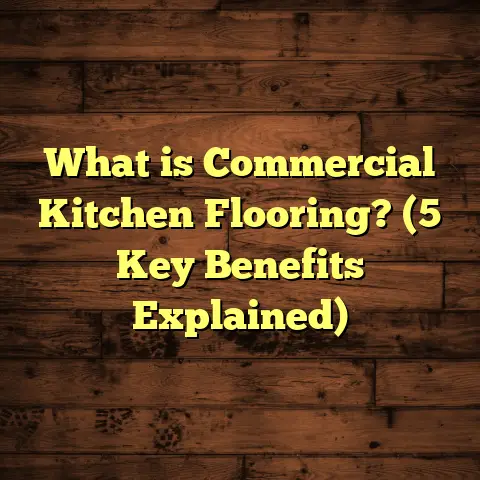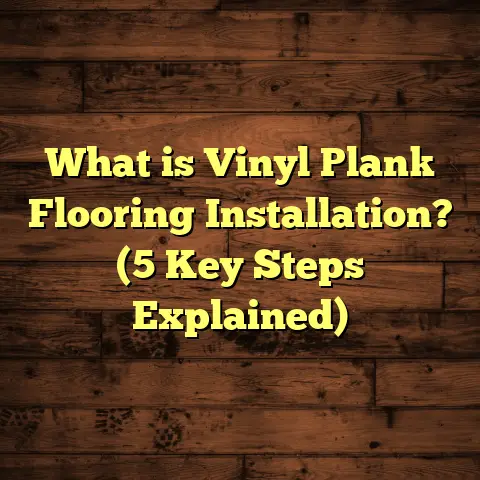What is Peel and Place Flooring? (5 Benefits You Didn’t Know)
Timeless floors have a way of defining a home. They’re more than just surfaces beneath our feet—they hold memories, tell stories, and set the tone for our daily lives. Over the years, I’ve worked with countless flooring materials, from hardwood to tile, but peel and place flooring is one that truly caught my attention for its unique blend of simplicity and effectiveness. It’s one of those innovations that makes you wonder why it wasn’t around sooner. If you haven’t heard much about it or are curious whether it fits your next project, let me walk you through everything I know—from what it is exactly to some surprising benefits that might just change how you think about flooring.
What Is Peel and Place Flooring?
Peel and place flooring is a category of floor covering where each plank or tile has a pre-applied adhesive backing covered by a protective liner. When you’re ready to install, you simply peel off this liner and stick the plank or tile directly onto your existing subfloor or prepared surface.
Think of it as giant stickers for your floors—except these stickers are designed to look like wood, stone, or ceramic, and they’re engineered to last. This makes peel and place flooring a subset of vinyl or laminate flooring but with a key difference: there’s no liquid glue, nails, or staples involved in installation.
The beauty of peel and place floors is their ease of use. You can lay them down without waiting for adhesives to dry or worrying about messy cleanup. It’s no surprise that these floors have become a favorite for DIY enthusiasts, quick renovations, and rental property makeovers.
A Closer Look at the Composition
Most peel and place flooring today is made from luxury vinyl planks (LVP) or vinyl tiles (LVT). The construction typically includes:
- Wear layer: This is the tough top layer protecting against scratches, stains, and scuffs.
- Printed design layer: The high-resolution image that mimics natural materials like wood grain or stone patterns.
- Core layer: Usually PVC or composite material that provides stability and some cushioning.
- Adhesive backing: Pressure-sensitive glue that sticks firmly to clean subfloors.
- Release liner: The paper or film you peel off before installation.
Each layer is designed for durability and aesthetics, giving you the look of high-end flooring without the hassle.
Why I Got Interested in Peel and Place Flooring
In my early days as a contractor, I mostly installed traditional flooring like hardwood and glued-down vinyl. But peel and place caught my eye during a small bathroom remodel when a client wanted quick results with minimal disruption. I gave it a shot, expecting an “okay” result. What I found was a surprisingly durable floor that looked great and held up well over time.
Since then, I’ve used peel and place flooring in various houses—from rental units needing fast turnovers to basements where moisture was a concern. It quickly became one of my go-to solutions when clients wanted affordable but attractive floors without a huge time investment.
How Does Peel and Place Flooring Work?
Let’s break down the installation process, so you understand why it’s such a game changer.
Step 1: Surface Preparation
The secret to peel and place flooring success lies in the prep work. The surface must be:
- Clean: No dust, dirt, grease, or debris.
- Dry: Moisture can weaken adhesive bonds.
- Smooth: Any bumps or cracks could cause tiles/planks to not lay flat or stick properly.
I’ve learned this the hard way—skipping prep meant planks started to lift after a few months. Taking time to sweep, mop, and sometimes sand rough patches pays off big.
Step 2: Measuring & Planning
You don’t just start sticking tiles randomly. Careful measuring and layout planning ensures your floor looks balanced and professional. For rooms with odd shapes or obstacles like cabinets, I dry-lay some tiles first to check patterns and cuts.
Step 3: Peeling & Placing
Here’s where the magic happens. You peel the liner off each plank or tile and carefully place it on the floor. The pressure-sensitive adhesive grips instantly but allows slight repositioning if needed.
I usually press down firmly with my hands first, then run a floor roller over the surface to secure adhesion evenly.
Step 4: Cutting & Finishing
Edges and corners often need trimming. A sharp utility knife works best here. I always take my time to get clean cuts because sloppy edges can ruin the whole look.
Once all tiles are down, a quick cleanup gets rid of any dust or fingerprints.
5 Benefits You Didn’t Know About Peel and Place Flooring
When I first started using peel and place flooring years ago, I thought its main draw was convenience. But as I gained experience, I discovered benefits that surprised me—and my clients too.
1. Speedy Installation Saves Time and Money
Time is often money in construction and home renovation. One reason peel and place flooring is so popular is how quickly it goes down compared to traditional methods.
For example, installing glued vinyl or laminate can take days because you have to apply adhesives carefully or allow click-lock systems to settle. Peel and place flooring cuts this down dramatically.
According to data from the National Wood Flooring Association (NWFA), peel-and-stick products can reduce installation time by 40-60%. That means what used to take two days can often be completed in half a day.
This reduction also affects labor costs—a big win if you’re hiring professionals or managing multiple projects yourself.
In one job I handled for an Airbnb host needing a fast turnaround between guests, we had just 24 hours to replace worn-out carpet with new flooring. Peel-and-place tiles made it possible without sacrificing quality or aesthetics.
2. Minimal Tools Required—DIY Friendly
One thing I love about peel and place flooring is how approachable it is for people without extensive DIY skills. You don’t need expensive glue guns, nail guns, or heavy-duty saws. Mostly just:
- A tape measure
- Utility knife
- Straight edge
- Floor roller (optional but helpful)
This simplicity lowers barriers for homeowners wanting to tackle projects themselves. When my sister decided to redo her kitchen floor on a tight budget, she managed the entire job solo using peel-and-place planks.
The satisfaction she got from transforming her space so quickly was priceless—and she saved hundreds on labor costs.
3. Durability That Surprises Even Pros
I’ll admit I was skeptical initially about how long sticky-backed vinyl could last under heavy foot traffic. But over years of installations, I’ve seen these floors hold up remarkably well.
Industry tests show peel-and-stick vinyl can resist abrasion equivalent to thousands of footfalls—comparable with traditional glued vinyl floors costing twice as much.
My clients often report no signs of peeling or wear after several years in kitchens, basements, and rental units.
It’s also water-resistant—an important factor if you’re considering it for moisture-prone areas like bathrooms or laundry rooms. Just remember proper subfloor preparation is key here.
4. Great for Temporary or Rental Spaces
If you’ve ever rented out property or worked with landlords, you know the challenge of balancing upgrades with cost-effectiveness.
Peel and place flooring offers an elegant solution because it’s removable without damaging subfloors significantly.
One landlord friend told me how he used peel-and-stick tiles in several rental apartments over five years. After tenants moved out, he could peel up old floors easily before installing new ones—saving both time and costly repairs.
This makes it ideal for anyone wanting flexibility without permanent commitment.
5. Environmentally Considerate Options Are Emerging
Sustainability has become increasingly important in building materials, including flooring.
I was pleasantly surprised when researching recent product lines to find several manufacturers now offering peel-and-place planks made partially from recycled content.
Additionally, many meet strict indoor air quality standards (FloorScore certification), which means lower VOC emissions—better for indoor health.
This shift makes peel-and-place options appealing not only for convenience but also for conscious consumers wanting greener choices.
Breaking Down the Costs: What Should You Expect?
Cost is always on everyone’s mind when planning flooring projects. Peel and place flooring generally sits at an affordable price point but varies depending on style, brand, and quality.
Here’s a general breakdown based on recent market research and my own projects:
| Type of Peel & Place Flooring | Price per Square Foot | Estimated Installation Time | Longevity |
|---|---|---|---|
| Basic Vinyl Tiles | $1.50 – $2.50 | 1-2 hours per room | 3-5 years |
| Mid-range Vinyl Planks | $2 – $4 | 2-3 hours per room | 5-7 years |
| Premium Luxury Vinyl Planks | $3 – $5 | 3-4 hours per room | 7-10 years or more |
You’ll also need to budget for preparation supplies (cleaners, rollers), cutting tools if you don’t already own them, and possibly sealing materials if installing over concrete prone to moisture.
How FloorTally Helps Me Nail Budgeting Every Time
Estimating costs accurately has always been one challenge in my work—especially juggling multiple projects at once.
That’s where tools like FloorTally come in handy. It lets me input local labor rates, material prices, waste factors (usually around 10% extra material for cuts/spares), and even visualize total costs clearly.
Using FloorTally helped me avoid common budgeting pitfalls like ordering too little material or underestimating labor hours on complicated layouts.
One memorable project was a basement makeover where we combined different plank styles for an accent wall effect. FloorTally allowed me to forecast expenses precisely before ordering materials—saving both money and time by avoiding multiple trips back to suppliers.
My Personal Experiences with Peel and Place Flooring
Let me share some real-life stories from my years of working with this versatile flooring type:
Story #1: The Kitchen Transformation
My sister’s kitchen had old linoleum that was cracked and stained beyond repair. She didn’t want a full remodel but craved something fresh and modern-looking without spending thousands.
We chose peel and place vinyl planks with a rustic oak finish. Over two days, she removed the old floor herself while I helped cut tiles around cabinets and appliances.
The result? A brightened space that looked professional but cost under $800 including tools. She still gets compliments whenever friends visit.
Story #2: Quick Rental Unit Turnaround
I once helped a landlord flip a rental unit after tenants left abruptly during winter.
The old carpet was ruined by pet stains, so we opted for peel-and-stick tiles that could be installed quickly despite cold weather conditions inside the building.
Installation took less than 24 hours total—and the landlord was thrilled because the unit rented faster than usual thanks to the fresh look.
Story #3: Basement Waterproofing Combo
Basements can be tricky due to moisture issues. In one client’s home where flooding was occasional but damaging, we sealed the concrete first with an epoxy primer before laying peel-and-place vinyl tiles designed specifically for damp areas.
This combo provided a waterproof floor solution that stayed intact through humid seasons without peeling or warping—a huge win for peace of mind.
Common Questions About Peel and Place Flooring
I get asked these questions all the time from clients considering this flooring option:
Q: Can peel and place flooring be installed over carpet?
A: Generally no. The adhesive needs a firm surface for proper bonding. Carpet is too soft and uneven. Remove carpet first then install on wood subfloor or concrete slab.
Q: How long does peel and place flooring last?
A: With proper care, expect 5-10 years depending on product quality and location (low traffic vs high traffic).
Q: Can I use peel-and-stick in wet areas like bathrooms?
A: Yes—but only if subfloor is dry/prepped correctly using moisture barriers/sealers. Not all products are rated for wet areas; check product specifications carefully.
Q: Is it easy to replace damaged tiles?
A: Very easy! Just lift damaged tile gently with a putty knife and stick down new one in its place—no mess required.
Q: Will pets damage this type of floor?
A: Peel-and-stick vinyl holds up well against pet claws compared to softer carpets but can be scratched by very sharp nails over time—regular nail trimming helps prolong life.
Maintenance Tips That Keep Your Floors Looking New
Caring for peel-and-place floors couldn’t be easier:
- Sweep or vacuum regularly to remove grit that can scratch surfaces.
- Mop with mild detergent solutions—avoid harsh chemicals or abrasive tools.
- Quickly wipe up spills to prevent staining.
- Use furniture pads under chairs/tables to avoid dents.
- Avoid dragging heavy objects which can tear adhesive bond.
Over the years, following these simple tips has helped many of my clients keep their floors looking fresh well beyond expected lifespans.
Design Flexibility: More Than Just Stickers on Floors
One aspect that surprised me initially was how many design options exist with peel-and-place floors today:
- Wood looks ranging from rustic oak to exotic walnut
- Stone patterns like marble or slate
- Ceramic tile visuals without grout hassles
- Even bold geometric patterns for modern interiors
Because each plank/tile is separate, you can mix styles or create custom layouts easily—something not always possible with glued floors or hardwoods.
A recent client wanted alternating light/dark planks in her hallway as an artistic feature. We pulled it off beautifully using different peel-and-stick vinyl planks at modest cost compared to custom hardwood work.
Final Thoughts on Peel and Place Flooring
Peel and place flooring offers more than just convenience; it delivers speed, affordability, durability, flexibility, and even eco-friendly options that fit various lifestyles and project needs.
From my personal experiences helping homeowners transform spaces quickly to landlords managing multiple rentals efficiently, these floors prove themselves time after time as practical yet stylish solutions.
If you’re thinking about refreshing your floors without hassle—or want a flexible option that can adapt as your needs change—you might find peel and place flooring exactly what you were missing.
Have questions? Or maybe you’ve tried peel-and-place before? Drop me a line—I’m always happy to chat flooring!





